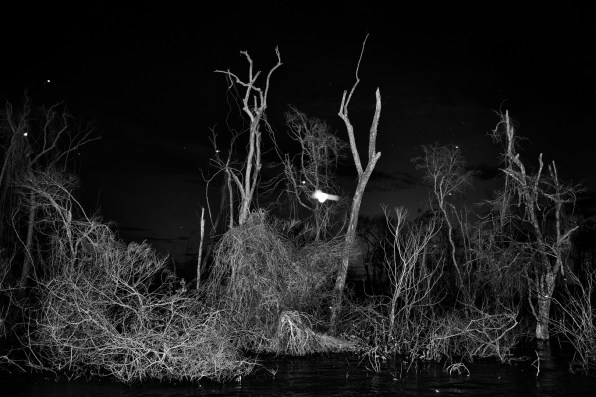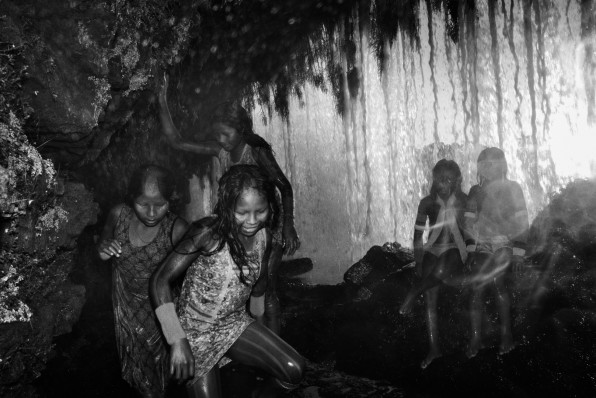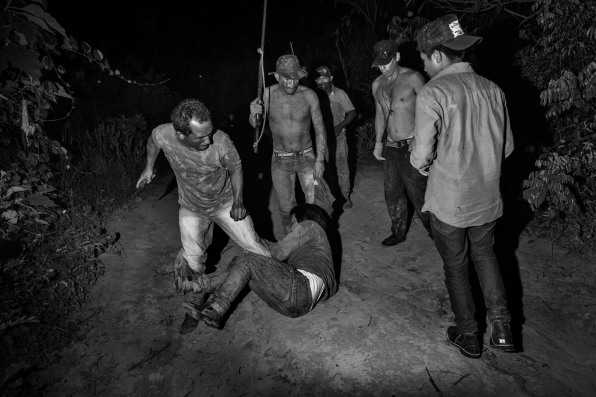As I write this, the Brazilian section of the Amazon rain forest is still actively being consumed by flames. The tropical South American forest, which covers a remarkable 2.1 million square miles in total, is home to one-10th of the world s species a wealth of biodiversity. Since the 1960s, the Amazon has been slowly and steadily cleared to make room for cattle and soybean production. And over the past two weeks, 76,000 distinct fires (the result of human interference and the dry season) have set the Amazon s trees ablaze, contributing to a loss of 7,000 square miles of forest approximately the size of New Jersey. The result? A tree-light forest, whose lungs are now unable to effectively inhale our planet s dangerous carbon dioxide emissions.
advertisementadvertisementThe Carmignac Photojournalism Award is an annual prize given to investigative photojournalists covering human rights violations. Each year, a team of environmental and political leaders selects a region to focus on and then selects a recipient, who uses the foundation s $55,000 prize money to shoot the project they proposed. The annual award, now in its 10th year, focuses on a different region and associated human rights topic each year; last year s iteration of the award documented the changing Arctic environment.
 Graja , Brazil A deforested area in the southern Maranh o state seen from a helicopter belonging to IBAMA, Brazil s national environmental agency. Maranh o is one of the worst affected by forest fires and illegal logging; it has lost 75% of its Amazon forest cover. The Amazon rain forest is losing a football pitch of forest cover every minute. Scientists say the Amazon is reaching a tipping point: If deforestation continues upward, the forest may never recover. [Photo: Tommaso Protti for Fondation Carmignac]
Graja , Brazil A deforested area in the southern Maranh o state seen from a helicopter belonging to IBAMA, Brazil s national environmental agency. Maranh o is one of the worst affected by forest fires and illegal logging; it has lost 75% of its Amazon forest cover. The Amazon rain forest is losing a football pitch of forest cover every minute. Scientists say the Amazon is reaching a tipping point: If deforestation continues upward, the forest may never recover. [Photo: Tommaso Protti for Fondation Carmignac]Last year, the jury chose to call for project proposals around deforestation and the Amazon. In an ironic twist, the recipient of the prize money was announced as the rain forest was being obscured by plumes of smoke from the unprecedented fires.
The winner, Tommaso Protti, is an Italian-born photographer who has lived in Brazil for the past five years. After being selected by a jury of artists, environmentalists, and activists including Yolanda Kakabadse, former minister of the environment in Ecuador and president of the World Wildlife Fund Protti received his $55,000 endowment in November 2018; the prize money supported the production of his photojournalism work, which began in January of this year and wrapped up in July. His reportage, developed in tandem with British journalist Sam Cowie, was revealed at the Visa pour l Image festival in France on September 4.
The geography of the land is enormous, says Protti, noting that the Amazon is roughly the size of Italy, Germany, and France combined. [It s] a really complex environment.
Protti traveled thousands of miles across the region, from the eastern region of Maranh o to the western region of Rond nia, to fashion a portrait of modern life in the Brazilian Amazon. The photographer, who shot these images with a digital Leica Monochrom camera, spent the greater part of three months immersing himself in indigenous communities (like the Ararib ia indigenous reserve in Maranh o state) to observe the intricacies of agriculture, politics, and tradition. His moody, sometimes ominous images channel the impending doom of a warming world left unchecked the shadow of corruption seems to hover just beyond the tree cover.
 Altamira, Brazil These trees died with the opening of the Belo Monte Hydroelectric Dam in Altamira, Par state, which flooded 400 square kilometers of forest. At the time of its construction, the dam was decried by environmentalists and civil society groups. Today, the project remains mired in controversy with serious questions regarding its viability and accusations of corruption during the bidding process. [Photo: Tommaso Protti for Fondation Carmignac]
Altamira, Brazil These trees died with the opening of the Belo Monte Hydroelectric Dam in Altamira, Par state, which flooded 400 square kilometers of forest. At the time of its construction, the dam was decried by environmentalists and civil society groups. Today, the project remains mired in controversy with serious questions regarding its viability and accusations of corruption during the bidding process. [Photo: Tommaso Protti for Fondation Carmignac]The images illustrate the precariousness of indigenous lives in particular. The rain forest territory is home to 30 million people, which includes 350 native groups. Rampant deforestation affects the complex ecosystem, which they depend on.
advertisementThere s a big problem with impunity inside the region because of the state it leads directly to killing the environment and indigenous leaders, Protti says. The people there don t have the protection [like most of us] experiencing climate collapse. The majority of the people I ve met try to make a living with what the forest offers them.
 Kayap Indigenous Land Kayapo children play behind a waterfall in the Kubenkr nken indigenous village, in southern Par state. The Kayapo have only been in contact with nonindigenous society since the 1960s. Their land serves as a crucial barrier to deforestation advancing from the south. [Photo: Tommaso Protti for Fondation Carmignac]
Kayap Indigenous Land Kayapo children play behind a waterfall in the Kubenkr nken indigenous village, in southern Par state. The Kayapo have only been in contact with nonindigenous society since the 1960s. Their land serves as a crucial barrier to deforestation advancing from the south. [Photo: Tommaso Protti for Fondation Carmignac]Poor environmental health in the Amazon is, in part, responsible for poverty and violence in surrounding favelas too. Rural agricultural workers, who depend on the forest for a living, have been forced to leave the Amazon now that it is less dense and farming has been modernized. The only place left for them to go are Brazil s cities, resulting in a crowding of favelas and the tension that results from a government pushing disparate communities into close proximity.
If you visit the cities that are all around, they have no control, Protti adds. There are key factors like impunity and violence and this influences and impacts all of the surrounding environments around the region.
 Ararib ia, Brazil Members of the Guajajara forest guard patrolling the Ararib ia indigenous reserve in Maranh o state beat another indigenous man who they suspect of collaborating with illegal loggers. The guard conducts thorough patrols of their vast indigenous reserve each month, destroying loggers camps and seizing equipment when possible. Sometimes, they catch the loggers red-handed, which can be dangerous as both groups are armed. In Maranh o and other Brazilian Amazon states, the vast majority of killings over land or resource conflict go unsolved. [Photo: Tommaso Protti for Fondation Carmignac]
Ararib ia, Brazil Members of the Guajajara forest guard patrolling the Ararib ia indigenous reserve in Maranh o state beat another indigenous man who they suspect of collaborating with illegal loggers. The guard conducts thorough patrols of their vast indigenous reserve each month, destroying loggers camps and seizing equipment when possible. Sometimes, they catch the loggers red-handed, which can be dangerous as both groups are armed. In Maranh o and other Brazilian Amazon states, the vast majority of killings over land or resource conflict go unsolved. [Photo: Tommaso Protti for Fondation Carmignac]One of Protti s selected photographs depicts members of the Guajajara forest guard beating an indigenous man accused of collaborating with illegal loggers.
Over the course of his time photographing the rain forest and its native people, Protti was able to observe how seasonal changes affect the Amazon s health, during the dry season (July through October) and the rainy season too. The joint work between Protti and Cowie explores the humanitarian crises plaguing the region from Venezuelan refugee groups to agrarian and religious conflicts and the ongoing deforestation too. It s a really complex award from my point of view. [The Amazon] is a national treasure, Protti says about his win. It s nothing new, fires happen every year . . . but at the same time, the fires are consequences of the social [situation].
Protti s photographs and the accompanying reportage will be presented in London and at the Maison Europ enne de la Photographie (MEP) in Paris starting December 4. They will also be included, concurrently, in a monograph copublished with Reliefs ditions.
advertisementadvertisementadvertisementFast Company Daily Newsletter
Sign UpReceive special Fast Company offers.See All NewslettersVideoImpact






 Ararib ia, Brazil A member of the Guajajara forest guard in a moment of sad silence at the sight of a toppled tree cut down by suspected illegal loggers on the Ararib ia indigenous reserve in Maranh o state. With deep cuts to Brazil s environmental and indigenous protection bodies in recent years, tribes across the Amazon are increasingly forming vigilante groups. [Photo: Tommaso Protti for Fondation Carmignac]
Ararib ia, Brazil A member of the Guajajara forest guard in a moment of sad silence at the sight of a toppled tree cut down by suspected illegal loggers on the Ararib ia indigenous reserve in Maranh o state. With deep cuts to Brazil s environmental and indigenous protection bodies in recent years, tribes across the Amazon are increasingly forming vigilante groups. [Photo: Tommaso Protti for Fondation Carmignac]